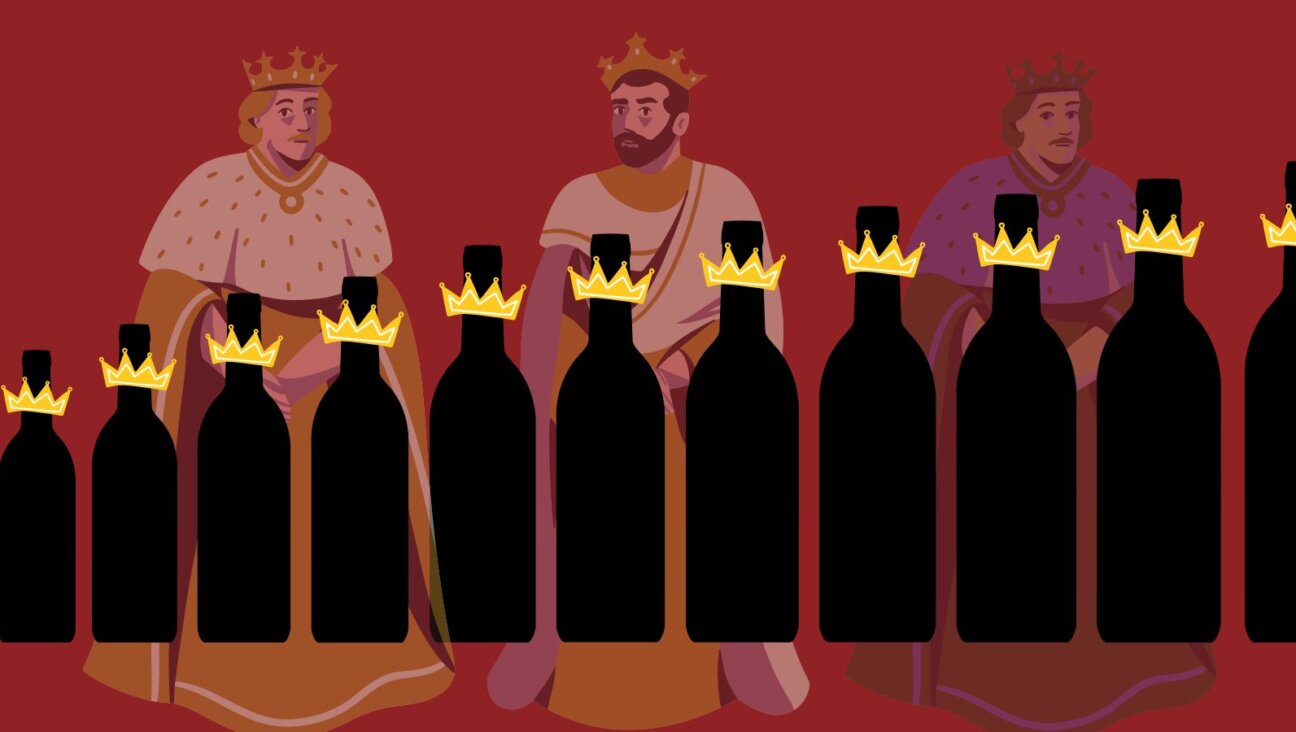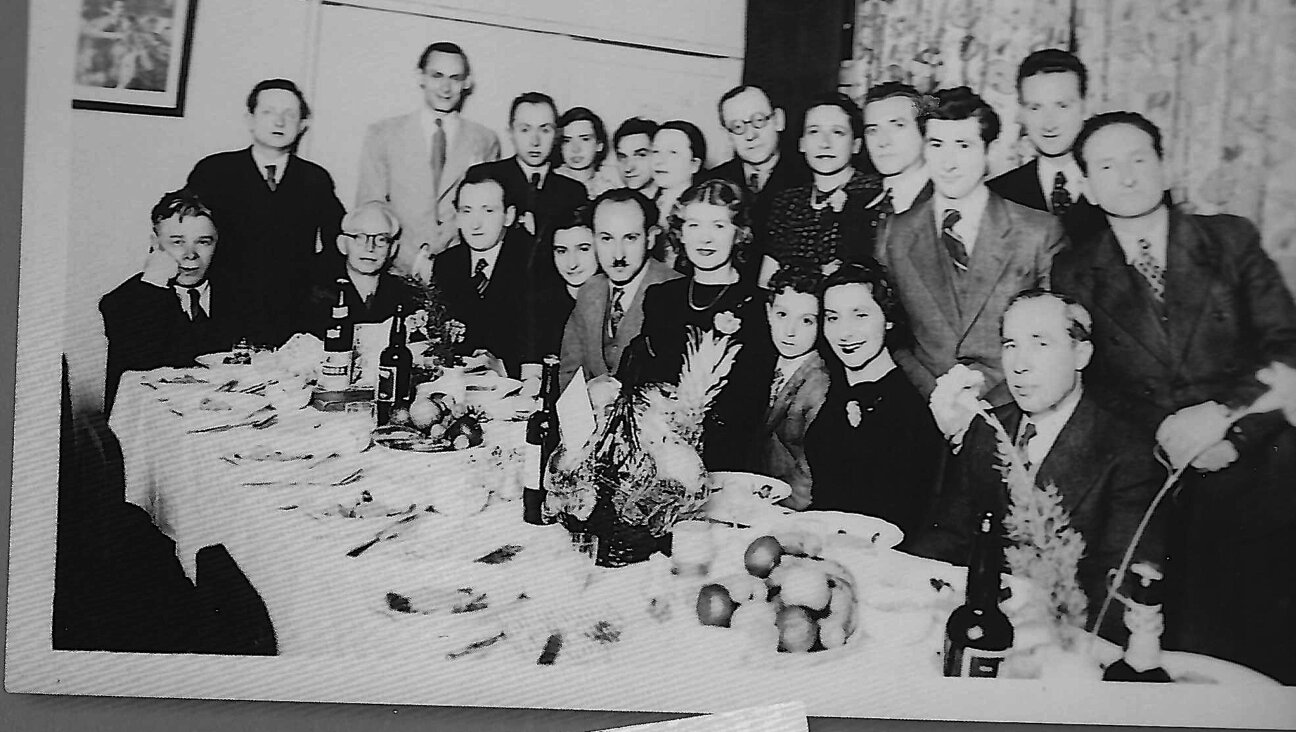How A Funny Jewish Game Called Rummikub Became An International Sensation

Image by Anya Ulinich
This past fall I visited my friends Geraldine and Israel, formerly of the Queens neighborhood Forest Hills, at their new rustic fixer-upper along the Hudson. The fireplace was working, the couch was in place, but the room was still surrounded by a cityscape of boxes waiting to be unpacked. Geraldine reached into one, grabbing something for Israel — a box she said was from his dad. Before she could pull it out, an idea passed through my mind: “I bet it’s a game of Rummikub.” It was.
The thought came to me like a line from a favorite movie. At home, I, too, had a faux-leather box with those metal clasps, stored in the back of my son’s closet, containing my family’s Rummikub set from my childhood. As the memories flooded back, a new thought came to me: Is Rummikub Jewish?
Bagels and lox are Jewish. Borscht Belt humor is Jewish. Soft-shell crabs are definitely not Jewish (but delicious nonetheless). Seltzer is Jewish (and the subject of my upcoming book). But can a game be Jewish, claimed as a cultural signifier? I decided to find out. Before long I found myself down a rabbit hole that led in many directions: to the founding days of Israel, to Don Rickles on “The Tonight Show With Johnny Carson,” to Communist Romania, ancient China and more.
But let’s start at the beginning, my beginning, with Rummikub. Growing up on Long Island in the era of Jimmy Carter and Ronald Reagan, it was clear to my sister and me that this game was different. First of all, Rummikub (pronounced “Rummy” + “Cube”) came not in a cheap cardboard box, but in a miniature briefcase. The opening of the metal clasps exposed the green lining and the clicky-clacky tiles inside. We’d dump them onto the table with a glorious cacophony. Then, there was the satisfying snapping of the two legs into the plastic tile racks. Once all the tiles were thoroughly shuffled, face down, on the table, the game could begin.

Image by Rummikub
If you haven’t played before, Rummikub is a rummy-style card game, but with tiles. The goal is to clear all the tiles from your rack. Melding tiles — and that’s the official word, “melding” — is how you get your tiles out on the table, by combining at least three tiles into runs (like 1,2,3) or sets (three or more of the same number). Once a run or set is on the table, a player can add on their own tiles. Players can also manipulate the tiles on the board — again, another term of art, “manipulation,” which we’ll come back to later — which means a player can reconfigure any melds already placed on the table (as long as no tiles are left outside of a legitimate run or set). If you can’t put any tiles on the table, you must add a new one to your rack; the first player to clear their rack wins.
Rummikub not only felt different from the run-of-the mill games played in our house, it was treated differently. On family vacations, this was the only game we traveled with. When my parents played, they played to win. It felt like this was their realm, and they were inviting my sister and me into it. Perhaps that’s why I presumed the game was an ancient family artifact, brought to America from the shtetl.
I couldn’t have been more wrong.
As it turns out, the game wasn’t just new to us; it was new to most Americans. It had been sold for a number of years, but sales didn’t take off until a 1977 appearance by Don Rickles on “The Tonight Show With Johnny Carson.” A frequent guest, Rickles would insult Carson while recounting tales from recent vacations. On this particular episode, Rickles regaled Carson with a story of his recent trip to Israel, where his wife couldn’t stop playing this “funny game,” Rummikub.

Don The Insult Comic: Don Rickles was partially responsible for the game’s success. Image by Wikimedia Commons
At the time, working out of a tiny New York City cubicle in the commercial delegation section of the Israeli Embassy, a recent college graduate and immigrant, Micha Hertzano, had spent the past year schlepping the game around town, to no avail. He went to all the toy fairs and department stores, but could never get past the assistants.
“I would give away my business card to anyone willing to take it,” he recently told me over email, “and a second later they would turn around and throw it away.” No one seemed to care about this funny game from Israel.
“The morning after the Johnny Carson interview I walked into the office,” he told me, “not expecting anything different, and I found about 400 messages.”
That one plug turned Rummikub into the top-selling U.S. game of 1977. “The Official Rummikub Book” came out the following year.
“Modern Rummikub sets come with rules for just one game,” John McLeod, owner and editor of pagat.com, an international encyclopedia of card and tile game rules, explained via email, “a manipulation rummy game that for most players nowadays is Rummikub.” Those rules are the ones I recognize from my childhood. However, the “Official Rummikub Book,” written by Hertzano’s dad, Ephraim Hertzano, describes three different games for the tiles: American, Sabra and International. Ultimately, the Sabra rules won out. “American and International Rummikub did not catch on and were dropped,” McLeod said. “The modern game is Sabra Rummikub.”
McLeod treats Hertzano’s book as if it were the urtext on Rummikub. And for good reason: Ephraim Hertzano wasn’t just an author suggesting rules for Rummikub — he invented it.

Founding Father: Ephraim Hertzano invented Rummikub. Image by WIkimedia Commons
Hertzano was born in Romania on January 27, 1912. After World War II, Communist-era laws banned the use of card games. Tiles, however, were permitted and can easily be exchanged for cards. McLeod told me that in post-war Romania it was normal to play rummy with a set of 106 tiles, equivalent in format to a Rummikub set. “In fact I have met Romanian players who say that until they traveled outside Romania they had not realized that people in other countries played rummy with cards.”
As an adult, Hertzano sold toothbrushes and perfumes. In 1960 he arrived in Israel, a fledgling country deep in an economic crisis. At 48 he needed a new profession. So he invented one. There were no toy stores in Israel at the time, but Ephraim had brought an idea for a game with him. In his Tel Aviv kitchen, and later his backyard, he handcrafted Rummikub sets, often with the help of his family, painting each tile and board, and sold the new tile game from the back of his car. His instructional book from 1978 would later emphasize how Israeli culture was infused into the game.
“Remember, this game began in Israel,” Hertzano wrote, “and Hebrew reads ‘backwards’ — from right to left — so Rummikub always goes counter-clockwise.”
In 1987, Ephraim died, at the age of 75, inspiring his children to launch the first Rummikub Championship. First hosted at Jerusalem’s Hyatt Regency, the competition is now held every three years, gathering the best players in the world, each representing his nation. It’s the Olympics of Rummikub, and whether they know it or not, they all play the Sabra way.
The most recent tournament, the ninth, was held in Germany in late 2015. Thirty-one nations competed, including New Zealand, South Africa, Bulgaria and Hong Kong. The top four players represented, in winning order, were Japan, South Korea, Slovakia and Holland. Coming in fifth, representing the United States, was a young Jewish man from Chicago, Alexander Siedband.
Siedband, a toy and game designer and a Solomon Schechter graduate, first played the game in high school, where a teacher introduced him to it. From there Alex brought it home, where his whole family adopted it, especially his mom. In fact, at the competition, as observers were looking for someone for whom to root, players shared who their “plus one” would be at the all-expenses-paid world championship. For Alex, it was his mom. “There’s nothing more I’d like to do for her,” he told everyone. “She’s my little travel buddy.”
A year later, Siedband brought his mom with him to Berlin. As soon as they arrived, Micha Hertzano, who still runs the company with his sister, Mariana, greeted them. “Micha is hugging my mother,” Siedband told me. “They really believe that Rummikub is a family,” he explained. It’s not just for families, it is a family.
After he took fifth place, what surprised Siedband the most was the level of attention from the international press. The United States seemed to be one of the few countries that didn’t pay it much mind. “Overseas they treat Rummikub like a Monopoly or a Scrabble,” he told me. “It’s very prestigious to be there.” According to data from the game publisher in 2013, Rummikub is the third most popular family game in the world, sold in 54 different countries in 26 different languages.

The Family In Action: The author’s family enjoys a game of Rummikub. Image by Courtesy of Barry Joseph
Though the game incorporates elements of chess, dominoes, rummy, and Mah-Jong, David Parlett, a game scholar, believes the Mexican game of Conquian is the ancestor of all Rummy games. The core mechanic of Rummy, however — drawing, melding and discarding — actually appeared in Chinese card games over two centuries ago. This eventually led to the games like Mah-Jong, which was created in the 1890s.
In other words, one can trace a line from Mah-Jongg’s ancestors in China, to Conquian in Mexico, to Rummy in Europe, to Rummikub in Israel, with the Rummikub championship, of course, bringing the line full circle back to Asia with Japan’s 2015 win.
Which leaves me with my initial question: Is Rummikub Jewish? Ultimately, I think what I found was not an answer but the realization that I had been asking the wrong question. I came to understand that what I really wanted to know was if I grew up with Rummikub because I was Jewish.
Harry Golden, a journalist who frequently wrote about Manhattan’s Lower East Side, once remarked, “There were many traditions which we associated with the Jewish civilization until some of us began to read the literature of the world.” With a broader awareness of the world, Golden learned that “many things were not ‘Jewish’ at all, but they were part of the tradition of all mankind.” I think that’s what happened with Rummikub and me — I needed to see the bigger picture to understand the game’s place within the play traditions of the world.
On the other hand there are still the Hertzanos. Micha told me about growing up near Tel Aviv, where the buildings were no more than a few stories high, all with street-facing balconies. “Engraved in my memory are Friday evenings,” he told me, “looking around and seeing all the other families sitting outside, playing Rummikub and having a watermelon.” The buildings were so close to one another that he could hear the sounds of the pieces on the board. “I would always look up at my father and see his face light up.”
Ephraim Hertzano shared his take on this scene in the introduction to his Rummikub book: “They say that on a summer night in Jerusalem and Tel Aviv the noise of the clacking of tiles on the balconies overhead is deafening!”
Perhaps, as a child, through playing the game, I could hear those echoes reverberating off the walls of my Long Island home.
Barry Joseph is an infrequent contributor to the Forward. One of his first articles is now being expanded into the upcoming book “Seltzertopia: The Effervescent Age.” Follow him on Twitter, @Seltzertopia

I hope you appreciated this article. Before you go, I’d like to ask you to please support the Forward’s award-winning journalism this Passover.
In this age of misinformation, our work is needed like never before. We report on the news that matters most to American Jews, driven by truth, not ideology.
At a time when newsrooms are closing or cutting back, the Forward has removed its paywall. That means for the first time in our 126-year history, Forward journalism is free to everyone, everywhere. With an ongoing war, rising antisemitism, and a flood of disinformation that may affect the upcoming election, we believe that free and open access to Jewish journalism is imperative.
Readers like you make it all possible. Right now, we’re in the middle of our Passover Pledge Drive and we need 500 people to step up and make a gift to sustain our trustworthy, independent journalism.
Make a gift of any size and become a Forward member today. You’ll support our mission to tell the American Jewish story fully and fairly.
— Rachel Fishman Feddersen, Publisher and CEO
Join our mission to tell the Jewish story fully and fairly.
Our Goal: 500 gifts during our Passover Pledge Drive!























